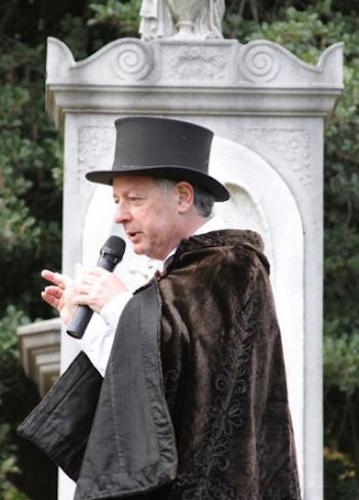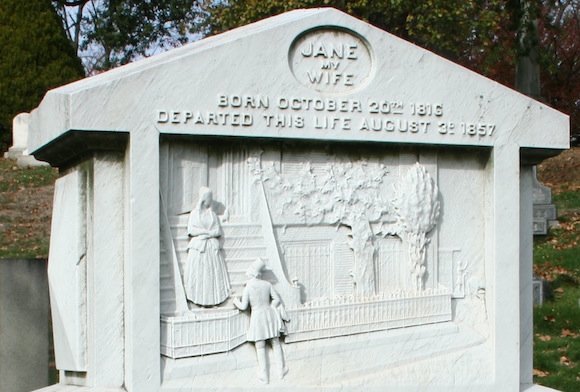
Most people probably think of Green-Wood Cemetery as the place at the end of the line, the place for the big sleep, the resting place at the end of your final act. For Jeff Richman though, it turned out to be a place of re-invention and second acts, where the former defense attorney could take his love of research and writing from the world of law to the world of the dead.
For fifteen years now, Richman has been in charge of leading tours, planning exhibitions, searching for gravestones and representing Green-Wood in the media as their official historian. How do you get such a cool job that lets you hang out in a 478-acre cemetery that’s also a National Historic Landmark? In part, you get in at the right time, and then make sure you’re as comfortable leading folks around as you are hitting the books. Richman gave us a look at his daily routine, his favorite parts of the job, and whether or not you have to believe in ghosts to keep a gig at Green-Wood.
How did you wind up in the field of cemetery history?
Cemetery history brings together many things I am interested in: research, writing, photographing, photographic history, landscape design, and memorialization. I practiced criminal defense law for 33 years. Late in that career, I was doing appeals–so I was no longer going to court daily or trying cases. So I wanted to do something with people–and have long loved cemeteries–so I decided that leading tours at Green-Wood was for me. That led to me researching and writing the book about Green-Wood, then working as the part-time historian, and ultimately as the full-time historian.
What’s the average day of the Green-Wood cemetery historian like?
It is usually a series of discoveries. I may be out on the cemetery grounds, finding a gravestone. Or I may be reviewing research from one of our Civil War Project researchers–then sending the research off to our editor–and reviewing our editor’s work of incorporating the new material into an existing biography. I may have meetings at Green-Wood on the two days a week I am there–exhibition planning, event planning, long-range work on our collections and/or archives. I am checking for items to add to our Historic Fund Collections–either by purchase or by donation. And I may be writing a blog post about a recent purchase, a museum exhibition related to someone interred at Green-Wood, or some sort of discovery or a preservation project at Green-Wood. Or I may be working on a new book–as author or editor–the publication of a self-guided walking tour, or an app. There might be a media interview–radio, television, part of a documentary.
Was leading tours something you had to get used to doing, or did you embrace it right away?
I have always enjoyed doing tours–what is better than sharing something you love with others? I led my first tour at Green-Wood in 1991–and enjoy doing tours now more than ever. However, it isn’t easy. I don’t think it is possible to do a perfect tour–but I am still trying.
Who comes up with the ideas and execution for the tours? Is it just you, or do a few people work together on it?
For years, I came up with ideas for tours. At first, I was limited by where we could walk in 2 hours–about 1/10 of Green-Wood’s area. Later, when we got our tour trolley, I was able to do more themed tours because we could cover the far corners of the 478 acres of the cemetery. So, I could do Civil War tours, women, artists, composers, and more. As our staff has expanded, tour planning has become more of a team effort–creating the tour that is needed to balance a very active calendar or to mark an event.

What kind of skill set do you need to excel at your job? Do you just need to be excited about hitting the books, or are there other skills people wouldn’t think of?
A broad range of skills are necessary. I lead tours, which require knowledge of the material, technique as a guide, and customer relations. I need research skills, writing ability, ability to recruit and effectively use volunteers, and more.
Is there a professional ladder people have to climb to wind up at a place as well-known as Green-Wood?
I was lucky to get in early, about 15 years ago, when Green-Wood was rediscovering its heritage of tourism and public programming. Today, it is quite a bit harder to get a job at Green-Wood–there are just more great candidates who are interested in working here.
What’s your favorite part of your job? Your least favorite?
Favorite part: constant discovery. I still go out on the grounds, after 24 years of wandering Green-Wood, and notice things I have never noticed before. I still regularly hear from people who share their wonderful stories. Least favorite: piles of papers everywhere. Biographies to be written, catalogues to be filed. I am sure my obituary will read: “Cemetery historian found underneath a large pile of papers.”
Has spending so much time around Green-Wood increased or decreased your belief in ghosts and other supernatural spirits?
Can’t say I am a big fan of the ghost angle. I do think that, at some level, there is sometimes something out there that reaches out to attract our attention–“look over here”–so that we notice what we have never noticed before. Spirits? Perhaps.

Do you have a favorite grave or memorial in all of Green-Wood?
The Griffith Monument is a tour de force of marble carving. It captures the scene as Charles Griffith left for work from his 16th Street brownstone–with the 6th Avenue horsecar waiting to take him downtown to work. His wife, Jane, stands on the steps of their home; when he returned that night he found her dead of a heart attack. So this monument has a poignant story behind it. And it also has tremendous detailing: the dog standing with Jane, the mail slot on the door, the wisteria growing on the fence, and more. Finally, this work is signed. For years, I could see the signature but could not make it out. Then, I was reading a book collecting columns of a New York Times writer from the 1950s–he talked about visiting this monument, and reported that the sculpture was signed “P. Piatti.” I went up to the New-York Historical Society and found a directory for this period–circa 1857–and in it was an advertisement for a marble carver–who specialized in mantles and cemetery monuments–by the name of Patruzio Piatti. Turns out Piatti, an Italian immigrant who carved this great work, is interred at Green-Wood–in an unmarked grave!
What kind of a person do you think would like your job? What kind of a person wouldn’t enjoy it?
A handsome, humorous, intelligent and kind person. Just kidding. I think this job works for me–I think I do a good job of prioritizing various projects and bring a variety of skills to the job. I don’t do anything perfectly–but I do a lot of things pretty well.
Does your job come with a friends and family discount for a burial space?
Well, not friends–but family–yes, indeed it does. I have taken advantage of the discount.
Keep your inbox from being a tomb, subscribe to our weekly newsletter!
Leave a Reply



